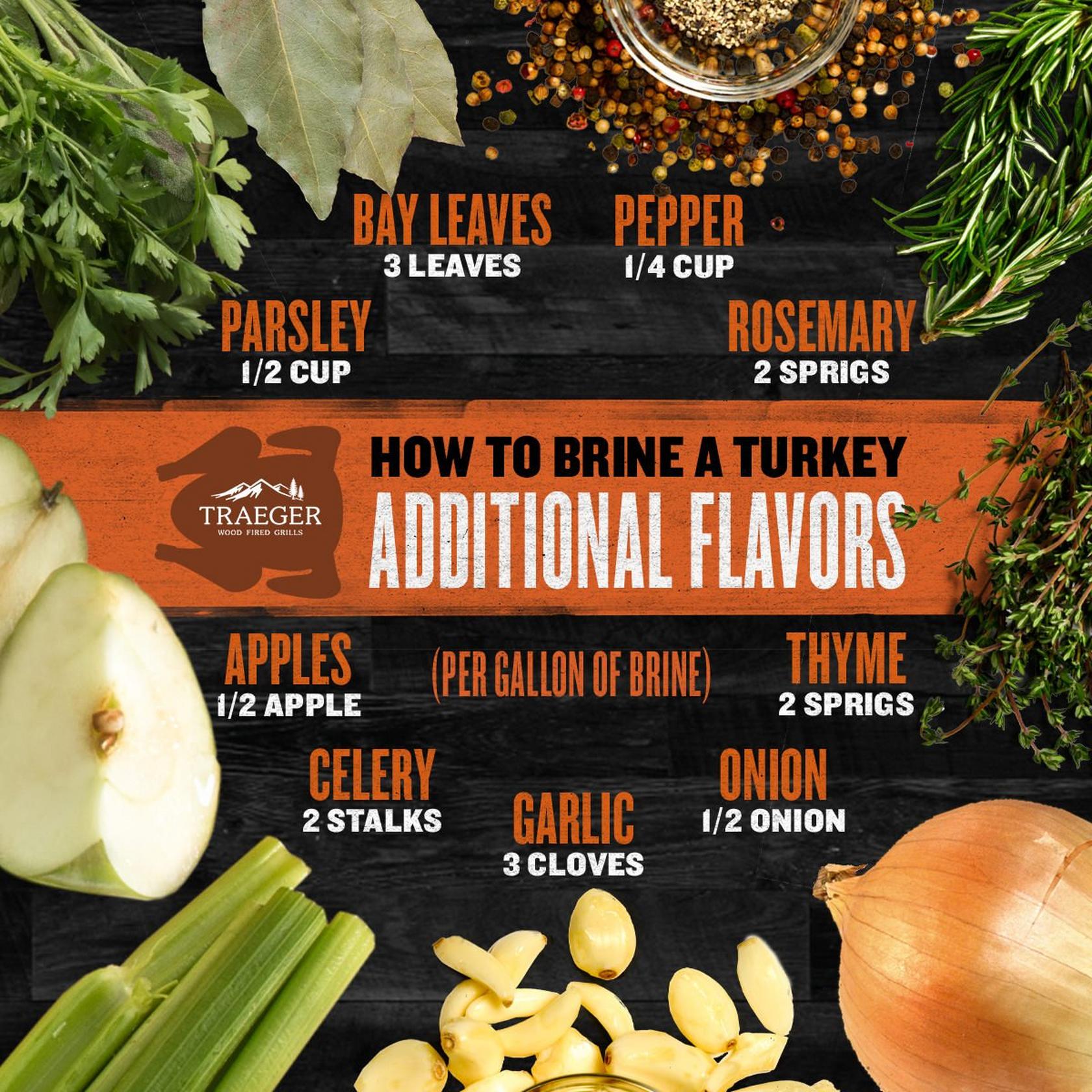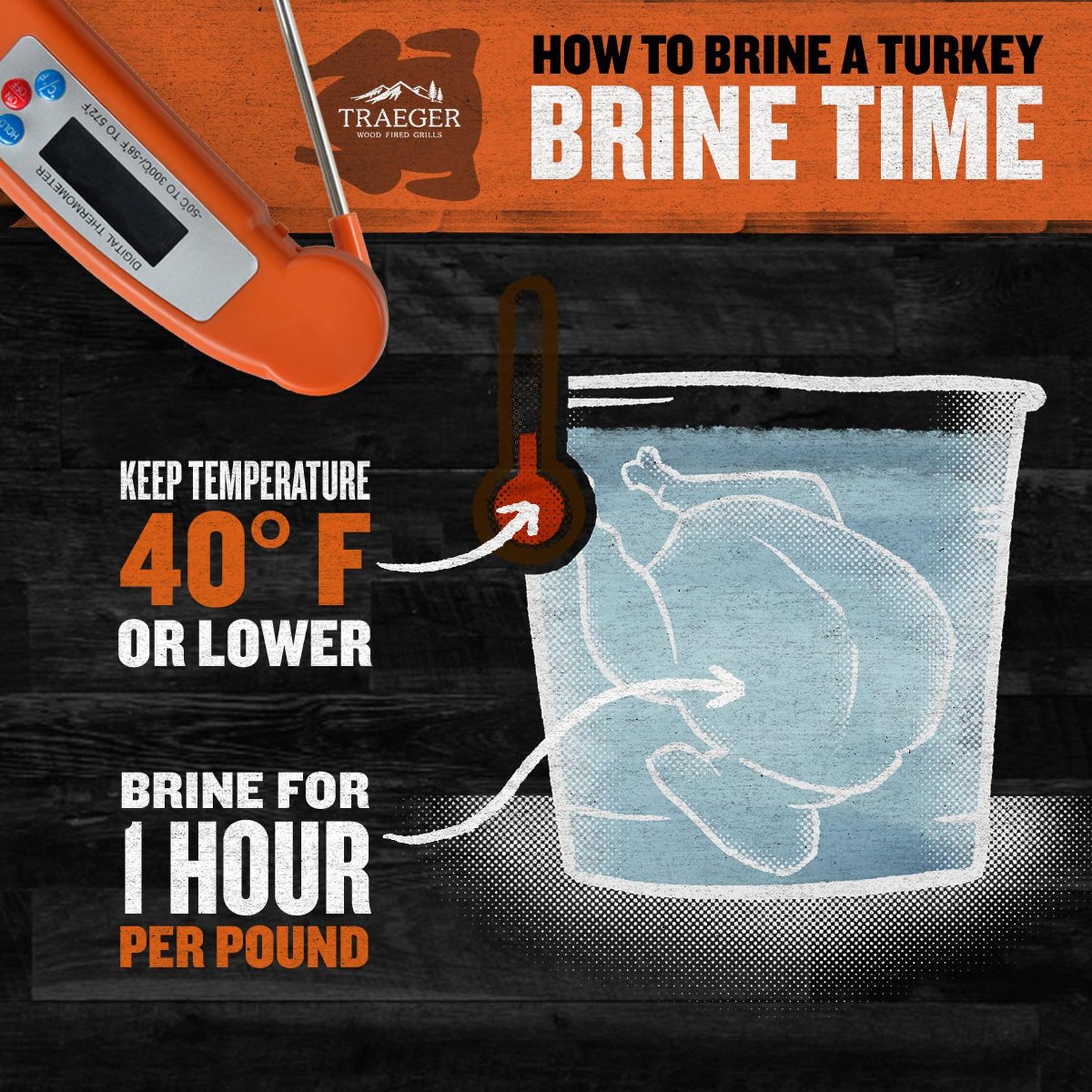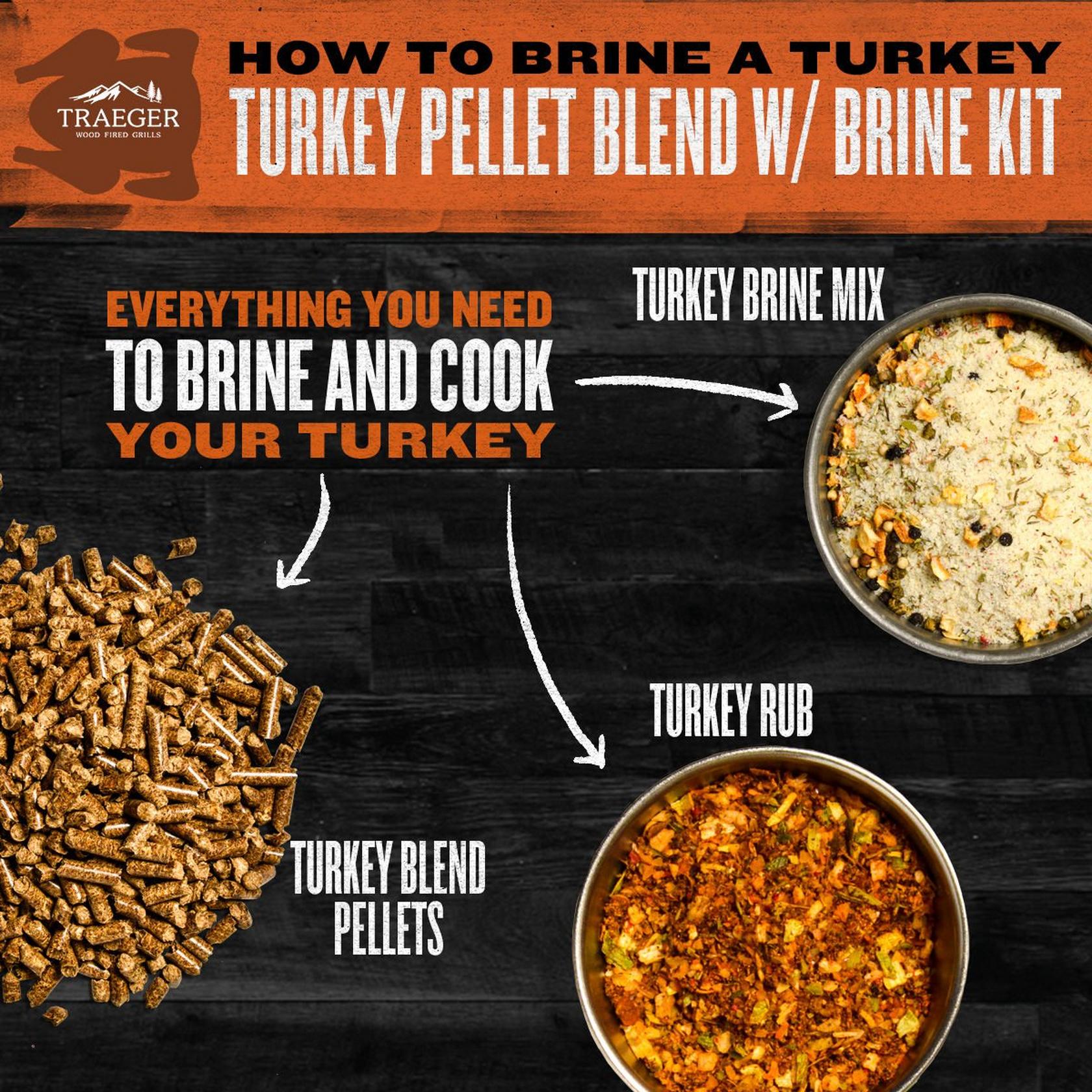Brining a turkey is the secret to nailing Thanksgiving dinner. Whether youre smoking it low and slow or roasting it to crispy, golden perfection, a good Traeger turkey brine locks in moisture while adding flavor to every bite of the meat. If you’ve ever wondered how to brine a turkey for smoking, it’s simpler than you think but delivers big results. This one step sets your bird up for maximum flavor, no matter which cooking method you choose. Read this expert guide before Turkey Day to learn all the secrets of successfully smoking a turkey.
Smoking a turkey on a Traeger pellet grill results in a juicy, flavorful bird with a delicious smoky flavor. With the right technique, you can have the star of your Thanksgiving meal ready with ease. In this article, we’ll walk through the full process of smoking a turkey on a Traeger, from preparation to carving.
Selecting and Preparing the Turkey
-
Choose a 10-15 lb turkey. Larger birds can be difficult to cook evenly. Opt for a fresh natural turkey rather than a frozen one.
-
Brine the turkey Dissolve 1 cup salt and 1/2 cup sugar in 2 gallons of water Submerge turkey and brine 12-24 hours Rinse and pat dry before smoking. Brining infuses flavor and moisture.
-
Apply a rub: Traeger’s Pork and Poultry Rub adds complementary flavor. Gently loosen the skin and apply rub directly onto meat.
-
Optional: Inject marinade into the breast and thighs for added moisture. Use a commercial injector or syringe.
-
Refrigerate uncovered 8-12 hours before smoking to allow the skin to dry out. This helps it get crispy.
Setting Up the Traeger Grill
-
Heat the grill to 165°F with lid open to prep the grill, then close lid and preheat 10-15 minutes until the grill stabilizes.
-
Use a milder wood pellet like Traeger’s Turkey Blend to complement the turkey flavor.
-
Place a disposable foil pan on grate below where turkey will sit to catch drippings. Fill with water, wine, broth or cider to make a flavorful ‘self basting’ liquid.
Smoking the Turkey
-
Place prepared turkey on grill breast-side up using a V-rack or poultry stand. Tuck wingtips under.
-
Smoke at 165°F for 1-2 hours until the skin starts to dry and change color. The low temp dries out the skin so it will get crispy.
-
Increase heat to 225°F to finish cooking. Estimate 15-20 minutes per pound, so a 15 lb turkey will take 4-5 hours.
-
Once the breast meat reaches 160°F and the thighs 175°F, the turkey is done. Carefully move to a cutting board and tent with foil to rest 20 minutes.
Serving and Carving
-
Carve the turkey and serve it up! The smoked turkey will have tender, juicy meat with smoky flavor throughout.
-
Use the jus in the foil pan to make an easy gravy. Whisk in flour to thicken, or use as is for rich turkey gravy.
-
Leftover smoked turkey is fantastic for sandwiches, soups, casseroles and more. Store carved meat in fridge for 3-4 days.
Turkey Smoking Tips and Tricks
-
Monitor the temperature using a wireless thermometer. Instant read thermometers also work to check doneness.
-
Spritz turkey with apple juice or broth every 45-60 minutes to keep the skin from drying out.
-
If the skin starts getting too dark, tent foil over it while continuing to cook.
-
Add a smoke tube for extra smoke flavor if desired.
-
Cook to proper temperature rather than time for best results. Every turkey and grill varies.
-
Let the turkey rest before carving. The juices redistribute and it finishes cooking.
With the right prep and technique, smoking a turkey on the Traeger grill results in the perfect centerpiece for your Thanksgiving table. For consistently juicy, flavorful results, follow these tips. The Traeger wood pellet grill does the hard work, infusing your turkey with delicious wood-fired flavor. Guests will rave about your Traeger smoked turkey for years to come!

How to Brine a Turkey For Smoking
When creating a Traeger turkey brine—whether for turkey, chicken, or a rack of ribs—there are a few key steps.
Before you even start, however, be sure you have procured a turkey that has not already been treated. For example, a kosher turkey has already been salted so brining it would result in it being too salty. You can also find pre-brined turkeys at the market, which have been injected with a brine. To determine if the turkey has been brined or salted, check the label and make sure there are no additional ingredients.
1. Plan ahead: For the best results, you will want to start the process a couple of days before you plan to cook your turkey (you can refer to this Thanksgiving Turkey Cook Time and Guide). If youre curious about how long to brine a turkey, plan for about 12 hours (though 24 is better). Then, once you remove it from the brine, you want to let it air dry for the crispiest skin, so plan for at least another 12 hours of drying or, better, another 24 hours. The general rule of thumb for brining is about 1 hour per pound of turkey, with 24 hours the maximum you should brine any bird. No matter how you flavor your brine, its critical that the brine temperature is below 40 degrees Fahrenheit when you add the turkey, and throughout the entire brining process, so make sure to clear some room in your fridge.
2. Find a container: Brining is not difficult to do and is mostly hands-off. The hardest part may be finding a pot large enough to hold your turkey in its brine and making space in your refrigerator for it. No room for that? You can double bag two unscented garbage bags, put the turkey in there, and then transfer the turkey in the bag to a large cooler. Pour in the cold brine to cover the turkey and tightly close each bag separately. Then keep the turkey cold and submerged by piling bags of ice over and around the closed bags. If using this method, be aware that you will likely need to add additional ice to keep the turkey at a safe, cold temperature (below 40°F).
3. Make the Brine: For a brine to be successful the solution needs to be super salty. Since salt crystals vary in size, the actual volume amount can vary, but most recipes suggest a ratio of 1 cup of salt per gallon of water. (At the very least, use ½ cup per.) Any salt will work here but keep in mind that not all salts are created equal. Table salt is a small crystal, whereas sea salt or kosher salt is coarser. Due to smaller crystals, 1 cup of table salt weighs more than 1 cup of kosher salt which means that your brine will be more concentrated if you use table vs. kosher. The different salts wont create much of a difference in the flavor profile but could change the salinity of your brine.
Most brines also contain sugar – brown or white. While sugar does not affect the texture of the meat, it does add flavor and promotes browning of the skin. Lastly, an easy way to add flavor to a brine is to add other liquids to it. Apple cider, stock, wine, beer, and booze are all great options. Never replace all the water in a recipe with these liquids; rather, think of them as an accent or additional flavoring. Adding very salty or acidic liquids such as vinegar, wine, or soy sauce can affect the flavor profile and saltiness of the finished product, so keep those additions to a minimum.
You can also add aromatics to your brine to subtly flavor your turkey. Garlic, onion, and fresh herbs are always good choices. Apples can add a slight sweetness while lemon and orange peel can add a bit of tang.
(For an easy brine that’s also delicious consider the Traeger Orange Brine and Turkey Rub Kit.)
4. Bring your brine to a boil, then let it cool completely: To allow the ingredients to completely mix and for the salt and sugar to dissolve, the brine must be brought to a boil. As important as the boil is letting the liquid cool. If the brine is warm when you submerge your bird, it will bring the temperature of the raw turkey into the bacterial danger zone. To cool your brine quickly, you can dissolve the salt and sugar in a smaller amount of water and then add cold water to it.
5. Submerge and brine the turkey: Once the brine is completely cool, add your turkey and keep it in the fridge for at least 12 hours and up to 24 hours. The general rule of thumb for brining is at least 1 hour per pound of turkey. If you need help figuring out how big of a turkey you should buy, read our guide.
6. Pat dry and let dry out: While the turkey brine helps moisten the meat, the skin needs to be nice and dry to get that crispy finish.
When you remove the bird from the brine, drain the cavity well, then pat the turkey dry.
If you have the time, transfer the turkey to a rack on a rimmed baking sheet and let it air dry uncovered in the refrigerator for at least a few hours and up to 24 hours. The skin will air out while retaining the birds internal moisture.
7. Smoke or Roast your Turkey: Once the turkey is sufficiently dry, it’s ready for roasting or smoking on your Traeger. You can add more flavor at this point, too, with, say a spice rub or flavored butter stuffed under the turkey’s skin. Whether you smoke it low and slow or roast it over high heat, your turkey will turn out beautifully.
What is a Smoked Turkey Brine Recipe?
Technically a brine is defined as water saturated with salt. Like we said above, a dry brine is also a great option for turkey, but for this article, we will be focusing on a liquid brine. At its most basic, a brine for pellet grill turkey is a mix of water and salt, but you can infuse extra flavor by adding other ingredients, such as sugar, garlic, herbs, and other liquids.
How To Smoke A Turkey On A Traeger Pellet Grill – FULL STEP-BY-STEP
FAQ
How long does it take to smoke a turkey in a Traeger?
- Small turkey (8–12 lbs): 2.5–3 hours at 325°F
- Medium turkey (12–18 lbs): 3.5–4.5 hours at 325°F
- Large turkey (over 18 lbs): Up to 6 hours at 325°F
How do you keep turkey moist in a pellet smoker?
How do you keep turkey moist in a pellet smoker? I highly recommend wet brining your turkey for at least 12 hours before cooking.Nov 27, 2024
Is it better to smoke a turkey at 225 or 350?
A smoker temp of 225 degrees will give you a nice smokey turkey with skin just like rubber. Any type poultry needs to be smoked at around 300 degrees to give you crisp skin. If you smoke at 225 you would need to either throw it onto a hot grill or into a hot oven meaning temps of 350 or higher to crisp the skin.
How to smoke a turkey without drying it out?
Dry-brining the bird by rubbing it with salt (or a spice rub that includes salt) and letting it sit in the fridge for a few nights in order to allow the salt to work its way into the meat and loosen up its muscle structure, thus keeping it juicy as it cooks.
Can you smoke a Turkey on a Traeger smoker?
Save this recipe for Traeger Turkey to Pinterest! You can certainly keep the turkey on your Traeger Smoker until the breast meat reaches 160 degrees F. I prefer another way. I’ve found that the best way to get a nice, brown, crispy skin on a smoked turkey is to pull it off the Traeger and finish the turkey in the oven.
How long do you cook a Turkey on a Traeger?
When ready to cook, set the Traeger temperature to 350˚F and preheat, lid closed for 15 minutes. Put the roasting pan with the turkey on the grill grate and roast for 2-1/2 to 3 hours, or until a temperature probe inserted in the thickest part of the thigh reads 165˚F.
How do you brine a Turkey a day before smoking?
The day before smoking, brine the turkey according to the Traeger Turkey Brine Kit package instructions. Remove from the brine, rinse. and pat dry. Season the inside cavity with 2 tablespoons of Traeger Pork & Poultry Rub. Use your hands to carefully separate the turkey skin from the meat over the breasts, creating a pocket.



